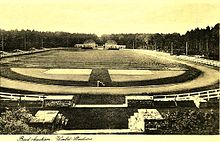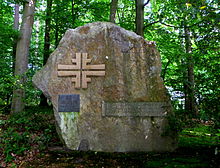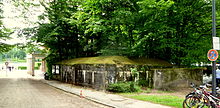Waldstadion (Aachen)
| Forest stadium | |
|---|---|

|
|
| Waldstadion (Aachen) | |
| Data | |
| place |
|
| owner | City Aachen |
| opening | October 15, 1927 |
| surface | Natural grass |
| capacity | 11,200 |
| Societies) | |
|
|
The Waldstadion Aachen is a municipal sports facility, which was rebuilt in 1927 in the south of the city of Aachen on the edge of the Aachen forest on I. Roten-Haag-Weg. This facility, consisting of a main and a side square, replaced the previously existing simple forest playground in the Aachen city forest with soccer field and was primarily used as a training and competition location for "general physical exercises " and all disciplines of athletics, and initially also as a field for field handball and soccer . Today's main stadium has more than 10,000 standing places and 1,200 seats, 400 of which are covered, and is equipped with floodlights. It meets the standard for regional, national and international championships. Only the connection to the parking lot is not optimal due to the near-natural villa-like buildings in the area and visitors from outside have to go to parking lots further away for major events.
The entire sports facility including the building for the official residence of the groundskeeper and the locker rooms were taken on 11 March 1980 in the register of monuments in the area of Aachen.
history
At the beginning of the 20th century there was a simple soccer field for the neighboring clubs from Burtscheid and Ronheide, the forest playground in the Aachen city forest , on which the young Alemannia Aachen played its first championship games in the then soccer association of Rhineland-Westphalia between 1904 and 1907 , before moving a few hundred meters further to the newly created space at the Siegel forest house. It was only several years after the First World War that the surrounding forest area was transformed into a place for leisure and sports activities as part of a fundamental reorientation. First of all, in the early 1920s, the city of Aachen built the Kupferbachstauweiher with a restaurant in the vicinity of the sports grounds and then renewed the old forest playground and sports field on Siegel. While the Siegel sports field was intended exclusively for football matches, the new Waldstadion was primarily intended to be used for physical exercises and athletics that were common at the time. In keeping with the spirit of the times, a large memorial stone was erected on which a plaque with the inscription: “ Max Schmid-Burgk , the sponsor of physical exercise” commemorates the sports sponsor of RWTH Aachen University . Furthermore, the symbolic gymnast's cross with the four “F” for “ fresh, pious, happy, free ” and a relief stone with the inscription “The herald of German unity, awakening of German nationality, founder of German gymnastics, Friedrich Ludwig Jahn ” reminds of him authoritative initiator of this gymnastics movement.
The Aachen Waldstadion was officially opened on October 15, 1927. From 1931 onwards, Alemannia Aachen also played again in the Waldstadion with a game against 1. FC Nürnberg . Up until the 1937/38 season, the football club played part of its games here, as this square, with standing room for almost 15,000 at that time, could hold more spectators than the Tivoli at the time . Mainly, however, the Waldstadion served the athletes and here in particular the athletics departments of the Alemannia Aachen and the German Athletics Club Aachen ( DLC Aachen ), which was split off in 1932 , as well as the DJK Frankenberg , the DJK lawn sport brand and for certain competitions of the Aachener TG , because the latter club only has a sports field with a short course.
During the Second World War , around 1941/42 in the course of the construction of numerous bunkers for the Aachen population, a relatively small raised bunker was built on the forecourt of the Aachen forest stadium, which still exists today but is not open to the public.
After the war, athletics could be resumed after the field was thoroughly renovated. In the 1970s, the running tracks were finally equipped with a modern tartan surface and along the home straight with a grandstand for 1200, of which 400 were covered, and with a modern floodlight system. The sports complex quickly became known far beyond the city limits due to its idyllic location and the low wind conditions due to the high number of trees. Since then, in addition to the routine training and competition operations of the athletics clubs, numerous well-known athletes from all over the world have come here again and again for competitions and a display board on one of the changing buildings attests to the best times and distances achieved in the stadium. The highlights so far have been the decathlon country comparisons between Germany and the USA in 1993 and 1999, as well as the German Senior Championships II (50-85 years) in 2006 and, as before, various regional, state and district championships every year.
In 1993, the Waldstadion Aachen also provided the backdrop for a classical music event, during which the world star Plácido Domingo also appeared.
Nowadays it is still the same clubs as in the early years that regularly use the Waldstadion Aachen. In addition, the city of Aachen provides the running tracks in the winter months from October to March on Mondays and Fridays from 6:00 p.m. to 8:00 p.m. as a floodlit training opportunity for the non-club members.
Furnishing
The main square complies with the standards for international competitions and championships and has 6 circular tracks that can be used on the grandstand side as a sprint straight for sprint competitions up to 110-meter hurdles . All the markings that are required for the various running competitions are in different colors on the tracks, which are equipped with tartan surfaces. The stadium also has two triple jump facilities , one of which can be run in both directions and both can also be used as a normal long jump facility , as well as two further long jump pits in the start area. Furthermore, the place is equipped with a pole vault system with two puncture boxes on the back straight and two normal high jump systems as well as a discus and two javelin devices. The inner area of the square is planted with lawn.
Around the main square a roughly 650 m long and 6 m wide warm-up track made of gravel was laid out, which also separates the main square from the adjacent square on its west side. On this area, which is provided with ashes, there are four more shot put facilities with partially overlapping sectors as well as a combined discus and hammer throw facility and a multiple jump pit .
In the western part of the two listed buildings are the groundskeeper's official apartment as well as the changing rooms and sanitary facilities for women and girls and a small sales room for refreshments. The opposite eastern wing of the building is available to the men and also has a room for strength training . Furthermore, there are utility rooms for equipment and materials as well as for the city employees on the site.
Stadium records
Men
| discipline | power | Surname | Association / Country | date |
|---|---|---|---|---|
| 100 m | 10.26 | Stanley Floyd | United States | 5th June 1987 |
| 200 m | 20.8 | Hartmut Wilke | TSV Bayer 04 Leverkusen | August 29, 1967 |
| 400 m | 45.48 | Ken Lowery | United States | 5th June 1987 |
| 800 m | 1: 46.0 | Willi Wuelbeck | TV Wattenscheid 01 athletics | May 30, 1986 |
| 1000 m | 2: 20.3 | Ibrahim Aden | Somalia | June 27, 2000 |
| 1500 m | 3: 36.4 | Rob Druppers | Netherlands | May 29, 1985 |
| 3000 m | 7: 49.7 | Julius Kariuki | Kenya | May 30, 1986 |
| 5000 m | 14: 04.2 | Harald Norpoth | Prussia Munster | June 9, 1966 |
| 10,000 m | 27: 43.3 | Paul Kipkoech | Kenya | May 30, 1986 |
| 4 × 100 m | 38.99 | Christian Haas / Volker Westhagemann / Norbert Dobeleit / Dirk Schweisfurth | DLV national relay | 5th June 1987 |
| 4 × 400 m | 3: 12.9 | LG PSV / WSV Wuppertal | Germany | July 26, 1970 |
| 4 × 800 m | 7: 28.2 | RFC Liege | Belgium | 23rd August 1966 |
| 4 × 1500 m | 15: 30.6 | RFC Liege | Belgium | 4th September 1968 |
| 110 m hill | 14.18 | Tom Pappas | USA decathlon team | August 8, 1999 |
| 400 m hill | 50.4 | Uwe Schmitt | Eintracht Frankfurt | May 30, 1984 |
| 3000 m Hin | 8: 27.7 | William Van Dijck | Belgium | May 30, 1984 |
| high jump | 2.34 | Carlo Thränhardt | ASV Cologne | July 6, 1983 |
| Pole vault | 5.52 | Tim Lobinger | Bayer Leverkusen | September 22, 1995 |
| Long jump | 7.68 | Ibe Philip | Bayer Leverkusen | August 7, 1999 |
| Triple jump | 16.84 | Peter Bouschen | LG Düsseldorf | July 6, 1983 |
| Shot put | 20.98 | Karsten pride | TV Wattenscheid | September 10, 1988 |
| Discus throw | 66.08 | Rolf Danneberg | LG Wedel / Pinneberg | May 30, 1984 |
| Hammer throw | 78.66 | Juha Tiainen | Finland | May 30, 1984 |
| Javelin throw | 76.28 | Klaus Tafelmeier | Bayer Leverkusen | May 30, 1984 |
| Pentathlon | 3726 | Frank Neuhaus | LG Rhein-Wied / Andernach | July 15, 1991 |
| Decathlon | 8264 | Mike Maczey | Decathlon wave SH | 7th / 8th August 1999 |
Women
| discipline | power | Surname | Association / Country | date |
|---|---|---|---|---|
| 100 m | 11.2 | Els Vader | Netherlands | May 30, 1984 |
| 200 m | 22.91 | Maja Azarashvili | Georgia | 2nd August 1994 |
| 400 m | 51.23 | Grit Breuer | LT Hannover | August 25, 1996 |
| 800 m | 2: 00.9 | Linda Kisabaka | Bayer Leverkusen | August 25, 1996 |
| 1000 m | 2: 56.7 | Manuela Preuss | Bayer Uerdingen | 4th August 1976 |
| 1500 m | 4: 06.9 | Sandra Gasser | Switzerland | 5th June 1987 |
| 3000 m | 8: 52.8 | Cornelia Bürki | Switzerland | 5th June 1987 |
| 5000 m | 16: 45.4 | Petra Maak | LAV Uerdingen / Dormagen | June 4th 1996 |
| 10,000 m | 35: 09.6 | Angelika Dunke | DLC Aachen | March 27, 1993 |
| 4 × 100 m | 43.8 | Resi March / Michaela Schabinger / Heidi-Elke Gaugel / Elke Vollmer | DLV national relay | May 30, 1984 |
| 100 m hill | 12.56 | Jordanka Donkova | Bulgaria | 5th June 1987 |
| 400 m hill | 55.74 | Heike Meissner | Dresdner SC | August 25, 1996 |
| high jump | 1.94 | Alina Astafei | USC Mainz | August 25, 1996 |
| Pole vault | 4.01 | Nicole Rieger | ASV Landau | August 25, 1996 |
| Long jump | 6.65 | Sharon Jaklowsky | Netherlands | August 25, 1996 |
| Triple jump | 14.06 | Galina Čisťakovová | Slovakia | August 25, 1996 |
| Shot put | 20.70 | Astrid Kumbernuss | SC Neubrandenburg | August 25, 1996 |
| Discus throw | 59.06 | Dagmar Galler | Bayer Leverkusen | June 19, 1982 |
| Hammer throw | 54.86 | Marion Große-Rammelkamp | ASV Cologne | 5th June 1994 |
| Javelin throw | 65.00 | Ingrid Thyssen | Bayer Leverkusen | 5th September 1981 |
| Heptathlon | 4748 | Christiane Blum | DJK lawn sport brand | June 16, 1984 |
Web links
Individual evidence
- ↑ Aachener Spielverein - The beginnings (Figs. 7, 9 and 20)
- ↑ Chronik Alemannia Aachen, (Column 1910–1945 - Section 1937/1938) ( Memento of the original from June 1, 2013 in the Internet Archive ) Info: The archive link was inserted automatically and has not yet been checked. Please check the original and archive link according to the instructions and then remove this notice.
- ↑ Placido Domingo on the tartan track , In: Aachener Nachrichten of August 13, 2007.
Coordinates: 50 ° 44 ′ 47 " N , 6 ° 5 ′ 40" E



